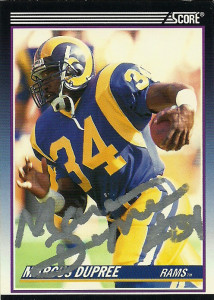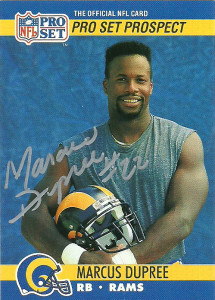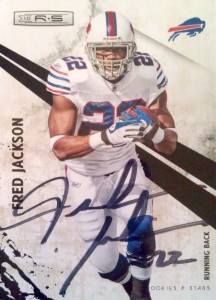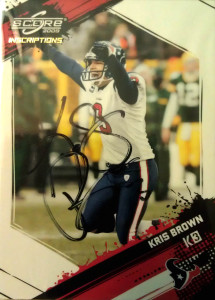Cards: ProSet 1990 Update, Score Supplemental 1990
Acquired: Paid Signing 2014, C/o Sportscollectors.net
Marcus Dupree was supposed to be the second coming of Earl Campbell at Texas in 1982. Instead Dupree was a major coup for Barry Switzer’s Oklahoma Sooners, as they sent none other than their more recent Heisman Trophy winner Billy Sims to pay Dupree a visit. Marcus was all that and more his Freshman year for the Sooners, as he was one of the most gifted pure runners to grace the college ranks. He’d pile up over 1100 yards and 13 touchdowns his Freshman year, to go along with a Fiesta Bowl record 239 yards rushing on just 17 carries. (Dupree averaged a whopping 7.8 yards a carry that Freshman year.) Midway through his Sophmore campaign though, Marcus quit the team, perhaps in part because he was rode so hard by the same coaching staff that welcomed him to Norman. He attempted to play for the Golden Eagles of Southern Mississippi, but ineligibility requirements held him out for the year.
Instead, Marcus resurfaced with the New Orleans Breakers of the upstart USFL in 1984. Throughout his rookie season he’d bide his time behind local product Buford Jordan, and have a decent year (684 yards and 9 TDs). As the USFL had financial issues, the Breakers quickly pulled up the tent stakes and moved to Portland the next season. Dupree assumed the starting role, but destroyed his left knee ligaments in the first game of the 1985 season. It’d be the second time he’d blow out his knee in a bit over a year. In 1986 after extensive rehab, he sought medical advice regarding his injury, but an orthopedic surgeon at Tulane doubted Marcus would ever play again. You see back in the ’80s things weren’t as automatic such as coming back from a knee injury- little less two. Still the Los Angeles Rams liked him enough that they took a stab at him in the 12th round of the NFL draft that year. Dupree in the meantime tried to move on, but an encouraging chance encounter with NFL great Walter Peyton, (who hailed only 125 miles from where Marcus grew up,) got Dupree thinking, so he whipped himself back into playing shape and decided to follow his ‘what if?’ dreams and try out for the NFL. -The year was 1990.
Marcus’ rights were still held by the Los Angeles Rams. The Rams were in transition at runningback. With the departure of underrated bellcow Greg Bell and head coach John Robinson needing a strong runner in the backfield, they decided to give Dupree a shot, based on the advice of Dick Coury (who was now on the staff of the Rams and was Marcus’ coach with the Breakers). Marcus came in and blew the Rams away, making the squad. It was a crowded backfield with Robert Delpino, Cleveland Gary, and Curt Warner, but Marcus made the best of it. The Rams, billed Marcus as the most intriguing comeback player of the year- ever. In his first game he wore 34 to honor Walter Peyton, who had done so much to encourage him to follow his dreams. Marcus had 22 yards on 4 carries after finally coming off the bench in week 9 against the Giants. It was heartwarming. He’d finish with 74 yards on the season. The NFL had seen enough, and while Marcus did not win NFL Comeback Player of the Year Honors, – Score football cards went ahead and crowned him their comeback player of the year anyway. 1991 was a bad season for the Rams, and proved to be John Robinson’s last, as the Rams slipped to 5-11, Dupree played in the last 8 games of the season. He’d score his first and only NFL touchdown in a 33-7 loss to the 49ers during week 12. After the season, Rams management cleaned house. Chuck Knox was brought in, and while he was famous for his ‘Ground Chuck’ offense, he did not feel that Dupree fit the mold of what the Rams were looking for. Marcus ran for over 100 yards in the final preseason game however, and I thought he’d be a lock to make the roster. He looked like the Dupree of old- but he was freakish at 6’2″, 225. He was a man of muscle and sinew. The same Dupree, just with more power and determination, that now ran under 4.5 with robotic knees. Knox cut Marcus anyway and I was very, very unhappy with the decision. (It openly made me question my loyalty to the team, but it didn’t matter since the Rams decided to bolt for St. Louis in 1995 anyway.) The 49ers scooped Marcus up and tried to convert him to fullback, but soon thereafter the ‘Marcus Dupree Experience’ was over.
He resurfaced with the Bossier City Battle Wings of the AFL2 where he served in the capacity of General Manager for the franchise. Marcus then returned to the NFL as a scout for the Washington Redskins in 2003. He’s also spent time as a promoter in wrestling. He also likes working construction. In 2010, ESPN aired a really touching “30 for 30” piece on Dupree entitled, “The Best that Never Was”. You can contact Marcus through his website where you can purchase an autographed copy of the film from him as well at www.themarcusdupree.com.
The Score Supplemental was signed with a dull marker. While the promoter apologized for the error and included an extra, it didn’t bother me that much, until I compared it to the finely signed ProSet Update that I was also given. Still these are two great cards, with the Pro Set being one of my favorite. When I saw this signing come up through Sportscollectors at such an affordable price, Marcus’ ProSet card immediately popped into my head. I sent the extra to a friend who I knew would appreciate it.
USFL Rush 162 Yds 753 Avg 4.6 Td 10 Lg N/a |
Rec 30 Yds 189 Avg 6.3 Td 0 Lg N/a
NFL 15/2 Rush 68 Yds 251 Avg 3.7 Td 1 Lg 24 |
Rec 6 Yds 46 Avg 7.7 Td 0 Lg 21



